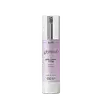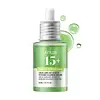What's inside
What's inside
 Key Ingredients
Key Ingredients

 Benefits
Benefits

 Concerns
Concerns

 Ingredients Side-by-side
Ingredients Side-by-side

Aloe Barbadensis Leaf Juice
Skin ConditioningArbutin
AntioxidantArctostaphylos Uva-Ursi Leaf Extract
Skin ConditioningButylene Glycol
HumectantCaprylic/Capric Triglyceride
MaskingEthylhexylglycerin
Skin ConditioningGlycerin
HumectantGlycyrrhiza Glabra Root Extract
BleachingHydroxyethylcellulose
Emulsion StabilisingKojic Acid
AntioxidantAscorbic Acid
AntioxidantLactic Acid
BufferingMagnesium Ascorbyl Phosphate
AntioxidantNiacinamide
SmoothingPentylene Glycol
Skin ConditioningPhenoxyethanol
PreservativePolysorbate 20
EmulsifyingPropanediol
SolventSodium Hydroxide
BufferingWater
Skin ConditioningCitrus Unshiu Peel Extract
MaskingDiacetyl Boldine
Skin ConditioningRumex Occidentalis Extract
Skin ConditioningAloe Barbadensis Leaf Juice, Arbutin, Arctostaphylos Uva-Ursi Leaf Extract, Butylene Glycol, Caprylic/Capric Triglyceride, Ethylhexylglycerin, Glycerin, Glycyrrhiza Glabra Root Extract, Hydroxyethylcellulose, Kojic Acid, Ascorbic Acid, Lactic Acid, Magnesium Ascorbyl Phosphate, Niacinamide, Pentylene Glycol, Phenoxyethanol, Polysorbate 20, Propanediol, Sodium Hydroxide, Water, Citrus Unshiu Peel Extract, Diacetyl Boldine, Rumex Occidentalis Extract
Water
Skin ConditioningPropylene Glycol
HumectantAzelaic Acid
BufferingSodium Hydroxide
Buffering1,2-Hexanediol
Skin ConditioningCentella Asiatica Extract
CleansingDipropylene Glycol
HumectantButylene Glycol
HumectantPanthenol
Skin ConditioningHydroxyethylcellulose
Emulsion StabilisingGlycerin
HumectantEthylhexylglycerin
Skin ConditioningMelia Azadirachta Leaf Extract
Skin ConditioningSalicylic Acid
MaskingBiosaccharide Gum-1
HumectantAllantoin
Skin ConditioningDipotassium Glycyrrhizate
HumectantMelia Azadirachta Flower Extract
Skin ConditioningSodium Hyaluronate
HumectantMelaleuca Alternifolia Leaf Oil
AntioxidantSuccinic Acid
BufferingTotarol
AntioxidantBeta-Glucan
Skin ConditioningDextrin
AbsorbentTheobroma Cacao Extract
Skin ConditioningCentella Asiatica Leaf Extract
Skin ConditioningCentella Asiatica Root Extract
Skin ConditioningMadecassoside
AntioxidantAsiaticoside
AntioxidantAsiatic Acid
Skin ConditioningMadecassic Acid
Skin ConditioningTocopherol
AntioxidantSqualane
EmollientZinc PCA
HumectantChlorella Vulgaris Extract
Skin ConditioningCeramide NP
Skin ConditioningSodium Hyaluronate Dimethylsilanol
HumectantHydrolyzed Hyaluronic Acid
HumectantHydrolyzed Sodium Hyaluronate
Skin ConditioningHyaluronic Acid
HumectantPotassium Hyaluronate
Skin ConditioningHydroxypropyltrimonium Hyaluronate
Sodium Hyaluronate Crosspolymer
HumectantSodium Acetylated Hyaluronate
HumectantWater, Propylene Glycol, Azelaic Acid, Sodium Hydroxide, 1,2-Hexanediol, Centella Asiatica Extract, Dipropylene Glycol, Butylene Glycol, Panthenol, Hydroxyethylcellulose, Glycerin, Ethylhexylglycerin, Melia Azadirachta Leaf Extract, Salicylic Acid, Biosaccharide Gum-1, Allantoin, Dipotassium Glycyrrhizate, Melia Azadirachta Flower Extract, Sodium Hyaluronate, Melaleuca Alternifolia Leaf Oil, Succinic Acid, Totarol, Beta-Glucan, Dextrin, Theobroma Cacao Extract, Centella Asiatica Leaf Extract, Centella Asiatica Root Extract, Madecassoside, Asiaticoside, Asiatic Acid, Madecassic Acid, Tocopherol, Squalane, Zinc PCA, Chlorella Vulgaris Extract, Ceramide NP, Sodium Hyaluronate Dimethylsilanol, Hydrolyzed Hyaluronic Acid, Hydrolyzed Sodium Hyaluronate, Hyaluronic Acid, Potassium Hyaluronate, Hydroxypropyltrimonium Hyaluronate, Sodium Hyaluronate Crosspolymer, Sodium Acetylated Hyaluronate
 Reviews
Reviews

Ingredients Explained
These ingredients are found in both products.
Ingredients higher up in an ingredient list are typically present in a larger amount.
Butylene Glycol (or BG) is used within cosmetic products for a few different reasons:
Overall, Butylene Glycol is a safe and well-rounded ingredient that works well with other ingredients.
Though this ingredient works well with most skin types, some people with sensitive skin may experience a reaction such as allergic rashes, closed comedones, or itchiness.
Learn more about Butylene GlycolEthylhexylglycerin (we can't pronounce this either) is commonly used as a preservative and skin softener. It is derived from glyceryl.
You might see Ethylhexylglycerin often paired with other preservatives such as phenoxyethanol. Ethylhexylglycerin has been found to increase the effectiveness of these other preservatives.
Glycerin is already naturally found in your skin. It helps moisturize and protect your skin.
A study from 2016 found glycerin to be more effective as a humectant than AHAs and hyaluronic acid.
As a humectant, it helps the skin stay hydrated by pulling moisture to your skin. The low molecular weight of glycerin allows it to pull moisture into the deeper layers of your skin.
Hydrated skin improves your skin barrier; Your skin barrier helps protect against irritants and bacteria.
Glycerin has also been found to have antimicrobial and antiviral properties. Due to these properties, glycerin is often used in wound and burn treatments.
In cosmetics, glycerin is usually derived from plants such as soybean or palm. However, it can also be sourced from animals, such as tallow or animal fat.
This ingredient is organic, colorless, odorless, and non-toxic.
Glycerin is the name for this ingredient in American English. British English uses Glycerol/Glycerine.
Learn more about GlycerinHydroxyethylcellulose is used to improve the texture of products. It is created from a chemical reaction involving ethylene oxide and alkali-cellulose. Cellulose is a sugar found in plant cell walls and help give plants structure.
This ingredient helps stabilize products by preventing ingredients from separating. It can also help thicken the texture of a product.
This ingredient can also be found in pill medicines to help our bodies digest other ingredients.
Learn more about HydroxyethylcelluloseSodium Hydroxide is also known as lye or caustic soda. It is used to adjust the pH of products; many ingredients require a specific pH to be effective.
In small amounts, sodium hydroxide is considered safe to use. However, large amounts may cause chemical burns due to its high alkaline.
Your skin has a natural pH and acid mantle. This acid mantle helps prevent harmful bacteria from breaking through. The acid mantle also helps keep your skin hydrated.
"Alkaline" refers to a high pH level. A low pH level would be considered acidic.
Learn more about Sodium HydroxideWater. It's the most common cosmetic ingredient of all. You'll usually see it at the top of ingredient lists, meaning that it makes up the largest part of the product.
So why is it so popular? Water most often acts as a solvent - this means that it helps dissolve other ingredients into the formulation.
You'll also recognize water as that liquid we all need to stay alive. If you see this, drink a glass of water. Stay hydrated!
Learn more about Water